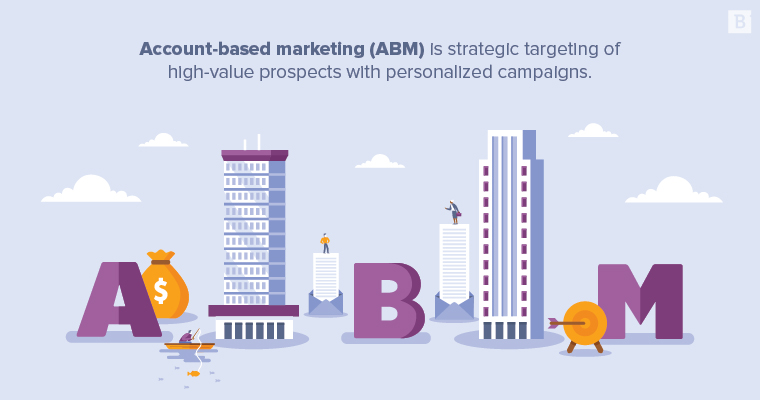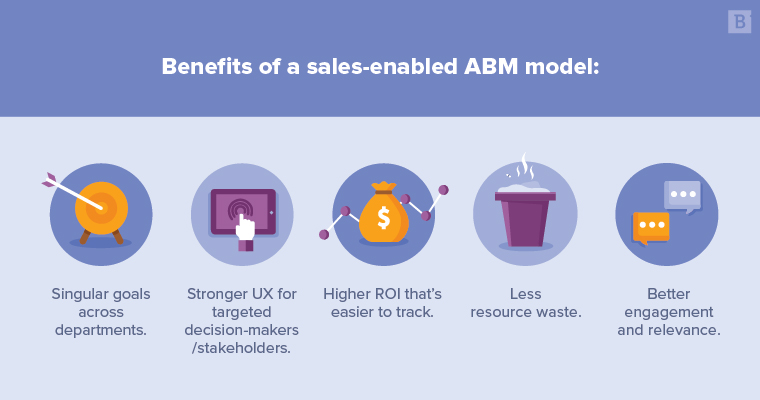Updated July 2020.
ABM: another acronym. So what does it mean?
Account-based marketing (ABM) is the strategic targeting of high-value prospects with personalized content and campaigns. ABM concentrates the vast majority of sales and marketing resources toward a small number of accounts that have the potential to lead to higher ROI, rather than spreading investments across a larger set of accounts.
In practice, it’s quality over quantity.
And it’s on the minds of today’s B2B marketers, mainly for its methodology of aligning sales teams and marketing departments into twin-powered lead generation engines.
But what’s behind the rise of ABM?

Targeting accounts
ABM is all about targeting.
Within every company’s database there are certain high-value leads that enormously outweigh the collective value of lesser-known, smaller accounts.
By targeting only those high-end accounts, marketers forgo cold calls, direct mail and impersonal messaging. Everything is, in essence, hyper-specific and completely calculated to nurture profitable long-term relationships with the few accounts identified as the most valuable.
Onboarding three large clients for a total revenue of $6 million, for instance, is thus considered more efficient than onboarding 15 smaller clients for the same dollar amount.
That said, if a marketer whiffs and only collects two of those three big-brand accounts, the financial fallout is much more serious. ABM is about finding the best way to divide resources and efforts across the entire marketing funnel to improve ROI.
Personalization in content
Once specific accounts are identified, the next step is to personalize account-based advertising campaigns to perfectly suit the target audience (typically stakeholders like the CMO, marketing manager and sales team), who may be involved on the client side at each stage of the funnel.
This does not, yet, mean creating individual buyer personas but rather a few organization-level tiers of messaging. For instance, executive, managerial and staff.
Starting out, your first outreach efforts should be personalized to these general positions within two or three companies. As you gain traction – e.g., open rates, responses, demo requests – you can drill down further into more specific persona mapping.

The key at this point is that you don’t want to devote too many resources to buyer personas if you’ve yet to get a foothold within an organization. But, if or once you do, you can pull resources from less-fruitful campaigns and invest them in ones that are gaining momentum.
When siloing marketing budgets of this size to so few high-risk, high-reward efforts, you have to be even more scrupulous with your time and money than when targeting prospects in the traditional sense.
Why ABM Stands out From Traditional Digital Marketing
In account-based marketing, you speak to businesses as a whole, which differs from many other types of marketing.
Because today’s business decisions are jointly made by anywhere between seven and 20 stakeholders, traditional prospecting is growing more difficult. That’s why ABM promotes the understanding of all the people within the stakeholder supply chain who comprise a single “account.”
Inbound digital marketing relies on top-of-funnel assets that draw users in organically (aka you cast a very wide net). ABM essentially flips the traditional funnel on its head: You remove soft leads from the equation entirely and focus only on companies that are very likely to become customers at some point.
Within your target organizations, you then convince their stakeholders to advocate on your behalf (becoming brand champions).
ABM by the Numbers: Who’s Using it?
Only 0.75% of leads result in closed revenue, so chasing millions of leads doesn’t necessarily improve your sales pipeline or bottom line. Therein lies the appeal to ABM: the ability to know what you’re investing in lead generation will pay off in the end.
Today, 55% of B2B organizations interviewed by Forrestor rated their ABM solution as “established” compared to just 43% two years prior.
Since the awareness of account-based marketing has increased in recent years, it’s easier to see how adopting this marketing strategy can be beneficial. Out of those firms that have already experimented with ABM, 97% report higher ROI relative to traditional marketing activities, and 85% state that ABM allows for greater client retention and upsell opportunities.
In fact, 77% of ABM users achieve 10% or greater ROI. Don’t think of account-based marketing as putting all your eggs in one basket, but instead as focusing your attention on carefully attending to a few eggs that you can nurture and hatch for a greater return on your investment.
Benefits of a Sales-Enabled ABM Model
The overarching utility of an ABM model is a more seamless sales-marketing alliance.
As every marketer can contest, uniting these two departments, or at least making them operate with the same mindset, is the organizational goal of goals. Sales reps then become marketing assets and marketing teams facilitate sales enablement.
More specifically, ABM benefits include:
- Singular goals across departments.
- Stronger user experiences for targeted decision-makers and stakeholders.
- Higher ROI that’s easier to track.
- Less resource waste.
- Better engagement and relevance.
The No. 1 challenge B2B marketers face is high-quality lead generation, so ABM is a natural next step for the vast majority of businesses. If the old philosophy of “80% of your sales come from 20% of your clients” is true, why bother talking to everyone else?
Common ABM Challenges
As stated, ABM is not without its drawbacks, and, at a basic level, smaller organizations will have an inherently more difficult time succeeding under this model.
That’s because ABM:
- Is very resource intensive.
- Has a very narrow and slow sales funnel.
- Requires marketing automation tools that may be expensive.
- May alienate other audience segments.
- Necessitates a high level of skill in content production and personalization.

Allocating the vast majority of your marketing budget toward three accounts is very risky if your team or agency partner is not able to effectively execute on every touchpoint of the campaign for a sustained amount of time. One misstep could sink the entire account, thus sending one-third of your budget down the drain.
For businesses just starting out, account-based marketing software can offer the tools needed to pinpoint the ideal customer profile and avoid some of these common missteps. Account marketing systems armed with predictive analytics can help B2B businesses gain insight into the customer experience and behavior to identify the most promising leads.
Even businesses like LinkedIn have thrown their hat into the ABM arena with their analytics and customizable features. Smaller marketing teams can easily utilize this networking platform and other social media to ensure their campaigns are being viewed by their target audience, as well as to track the success of their content.
Does ABM Work?
Whether ABM will work for your organization is completely dependent upon investment and execution.
But, speaking from an industry standpoint, yes, ABM has been proven to drive results for those companies that have implemented it. With 97 percent reporting higher ROI, that’s pretty conclusive evidence to argue against.
Marketers have witnessed the gains other companies have experienced from implementing an account-based marketing strategy and are ready to begin incorporating it themselves. Across departments, teams are becoming more receptive to ABM and you’ll be hard-pressed to find a CEO who isn’t interested in comprehensive account-based sales and marketing alignment.
As martech capabilities expand and ABM software becomes commonplace, the barriers to utilizing ABM solutions may be lowered for many B2B firms, making its adoption more ubiquitous moving forward.
ABM is shown to outperform traditional marketing in:
- Close rates.
- Customer lifetime value.
- Contract value.
- Accurate measurement and attribution.
Content Marketing Within ABM
B2B companies already have the ABM wind in their sails should they be interested in full-scale adoption.
That’s because the majority of businesses employ content marketing, an existing structure which ABM can complement.
The only way to create a unique customer journey is to produce content of all types. Email and social touchpoints must include content that’s targeted and engaging, making ABM a perfect vehicle for which to ramp up content production.
In many ways, ABM is a natural evolution of this kind of already highly personalized marketing. Consider adapting your content approach into different ABM categories: one-to-one, one-to-few or one-to-many. You can still create content that can be customized for multiple target audiences, and finding similarities between client profiles can be the first step in creating content that aligns with ABM.

ABM: Is it Worth Your Time?
Because it is so difficult to not only generate high-quality leads but to actually close those leads, every new marketing tactic is worth a try.
To ensure your ABM program is a surefire investment, conduct your due diligence first. Such items include:
- Do you have singular key accounts large enough to support dropping all other marketing programs?
- Do you have the automation, talent and experience to stick to ABM for a full year?
- Are you able to make reasonable projections for sale cycles and deal sizes?
- How sophisticated are your current content and email marketing efforts?
Answering these questions should give you a better idea of whether ABM is in your cards in the near future.
With customizable ABM platforms and software available, 62% of B2B businesses say they can accurately measure the positive impact from adopting it. By being able to quantify this investment, businesses can continue to expand or decrease their ABM efforts to meet their budgeting and sales needs. If you do invest in AMB, make sure to monitor its results to see if it’s the best fit for your company.

Conclusion
ABM may be on the tips of marketer’s tongues, but for smaller teams with fewer resources, it’s likely not a realistic investment.
Because of the time, resource and labor commitments, ABM is more so a strategy for companies that are already well-versed in B2B marketing and have solid teams, pipelines and targeting tactics in place.
But that shouldn’t discourage marketers from at least integrating some of the core tenets of ABM into their programs, such as personalized campaigns, customer segmentation, lead qualification and sales alignment. As social platforms begin offering ABM capabilities of their own, account-centric marketing will become more attainable for smaller businesses seeking the benefits of enhanced lead generation.





